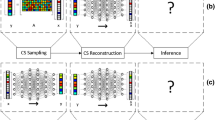Abstract
Multi-user detection allows for the efficient use of bandwidth in Code-Division Multiple-Access (CDMA) channels through mitigation of near-far effects and multiple-access noise limitations. Due to its inherent noise and multipath immunity, CDMA multi-access is being considered as a platform for personal communication systems (PCS). As CDMA based digital communication networks proliferate, the need to determine the presence of a new user and integrate knowledge of this new user into the detection scheme becomes more important. The decorrelating detector is a linear multi-user detector that is asymptotically optimal in terms of near far resistance; however, in the presence of a new unknown user, performance of the decorrelator is severely degraded. Adaptive decorrelators are constructed which adaptively augment an existing conventional decorrelator to demodulate a new active user in addition to existing users. Several likelihood ratio based schemes are employed. Both synchronous and asynchronous communication are investigated.
Similar content being viewed by others
References
M. Basseville and I. V. Nikiforov,Detection of Abrupt Changes: Theory and Application. Englewood Cliffs: Prentice Hall, 1993.
K. W. Halford and M. Brandt-Pearce, “User identification and multiuser detection ofl out ofk users in a CDMA system,” inProceedings of the Twenty-eighth Annual Conference on Information Sciences and Systems, Princeton University, New Jersey, pp. 115–120, 1994.
R. A. Horn and C. R. Johnson,Matrix Analysis. Cambridge: Cambridge University Press, 1985.
A. Householder,The Theory of Matrices in Numerical Analysis. New York: Blaisdell Press, 1964.
D. Kazakos, “Asymptotic error probability expressions for multihypothesis testing using multisensor data,”IEEE Transactions on Systems, Man, and Cybernetics, Vol. 21, pp. 1101–1114, 1991.
D. G. Luenberger,Optimization by Vector Space Methods. New York: John Wiley & Sons, 1969.
R. Lupas and S. Verdú, “Linear multiuser detectors for synchronous code-division multiple-access channels,”IEEE Trans. Inform. Theory, Vol. 35, pp. 123–136, 1989.
R. Lupas and S. Verdú, “Near-far resistance of multi-user detectors in asynchronous channels,”IEEE Trans. on Comm., Vol. 38, pp. 496–508, 1990.
U. Mitra and H. V. Poor, “Analysis of an adaptive decorrelating detector for synchronous CDMA channels,” inProceedings of the Seventh IEE European Conference on Mobile Radio and Personal communications, Brighton, UK, December 1993, pp. 155–160, IEE, 1993.
U. Mitra and H. V. Poor, “Detection of spread-spectrum signals in a multi-user environment,” inProceedings of the IEEE International Conference on Acoustics, Speech, and Signal Processing, Detroit, May 1995.
U. Mitra and H. V. Poor, “Activity detection in a multi-user environment,”Wireless Personal Communications, to appear in special issue on “Signal Separation and Interference Cancellation for Personal, Indoor and Mobile radio Communications”, in press.
U. Mitra,Adaptive Multi-User Detection. PhD thesis, Princeton University, June 1994.
H. V. Poor,An Introduction to Signal Detection and Estimation. New York: Springer-Verlag, 2nd ed., 1994.
D. V. Sarwate and M. B. Pursley, “Crosscorrelation properties of pseudorandom and related sequences,”Proc. IEEE, Vol. 68, pp. 593–619, 1980.
D. L. Schilling, R. L. Pickholtz and L. B. Milstein, “Spread spectrum goes commercial,”IEEE Spectrum, pp. 40–45, 1990.
D. Slepian, “The one-sided barrier problem for Gaussian noise,”The Bell System Technical Journal, Vol. 41, pp. 463–501, 1962.
A. Stuart, “Equally correlated variates and the multinormal integral,”Journal of the Royal Statistical Society, Vol. 20, pp. 373–378, 1958.
S. Verdú, “Minimum probability of error for asynchronous Gaussian multiple-access channels,”IEEE Trans. Inform. Theory, Vol. 32, pp. 85–96, 1986.
S. Verdú, “Recent progress in multi-user detection,” in1988 Conference Proceedings, International Conference on Advances in Communications and Control Systems and Lecture Notes in Control and Information Sciences Series, Vol. 129, NY: Springer Verlag, 1988, IEEE, 1988.
A. Wald,Sequential Analysis. New York: Wiley, 1947.
Author information
Authors and Affiliations
Additional information
This research was supported by the U.S. Army Research Office under Grant DAAH04-93-G-0219.
Rights and permissions
About this article
Cite this article
Mitra, U., Poor, H.V. Adaptive decorrelating detectors for CDMA systems. Wireless Pers Commun 2, 265–290 (1995). https://doi.org/10.1007/BF01099636
Issue Date:
DOI: https://doi.org/10.1007/BF01099636




